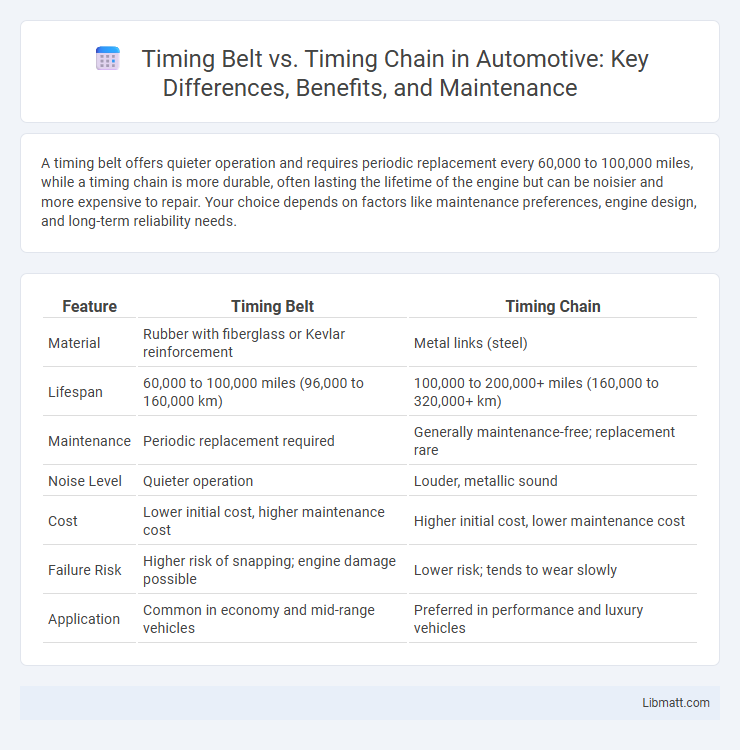A timing belt offers quieter operation and requires periodic replacement every 60,000 to 100,000 miles, while a timing chain is more durable, often lasting the lifetime of the engine but can be noisier and more expensive to repair. Your choice depends on factors like maintenance preferences, engine design, and long-term reliability needs.
Table of Comparison
| Feature | Timing Belt | Timing Chain |
|---|---|---|
| Material | Rubber with fiberglass or Kevlar reinforcement | Metal links (steel) |
| Lifespan | 60,000 to 100,000 miles (96,000 to 160,000 km) | 100,000 to 200,000+ miles (160,000 to 320,000+ km) |
| Maintenance | Periodic replacement required | Generally maintenance-free; replacement rare |
| Noise Level | Quieter operation | Louder, metallic sound |
| Cost | Lower initial cost, higher maintenance cost | Higher initial cost, lower maintenance cost |
| Failure Risk | Higher risk of snapping; engine damage possible | Lower risk; tends to wear slowly |
| Application | Common in economy and mid-range vehicles | Preferred in performance and luxury vehicles |
Introduction: Timing Belt vs Timing Chain
Timing belts are typically made of reinforced rubber and require replacement every 60,000 to 100,000 miles, offering quieter engine operation and lower initial cost. Timing chains, constructed from metal, provide greater durability with lifespans often exceeding 150,000 miles, though they can be noisier and more expensive to repair if issues arise. Choosing between a timing belt and timing chain depends on your vehicle's make, maintenance preferences, and expected engine longevity.
What is a Timing Belt?
A timing belt is a toothed rubber belt that synchronizes the rotation of the crankshaft and camshaft in an internal combustion engine, ensuring precise valve timing. It is renowned for its quiet operation and lightweight design but requires regular replacement, typically every 60,000 to 100,000 miles, to prevent engine damage. Unlike timing chains, timing belts are more susceptible to wear and can fail if not maintained according to manufacturer specifications.
What is a Timing Chain?
A timing chain is a durable metal chain that synchronizes the rotation of the crankshaft and camshaft, ensuring precise engine valve timing in your vehicle. Unlike timing belts, timing chains are typically made of metal, offering greater longevity and requiring less frequent replacement. Proper maintenance of the timing chain is essential to prevent engine misfires and costly repairs.
Key Differences Between Timing Belts and Timing Chains
Timing belts are made of reinforced rubber and require replacement every 60,000 to 100,000 miles, while timing chains are metal and typically last longer, often the lifetime of the engine. Timing belts operate more quietly and smoothly but are more prone to wear and require regular maintenance, whereas timing chains are more durable and less likely to stretch or break but can be noisier. The choice between timing belt and timing chain affects engine design, maintenance costs, and long-term reliability.
Advantages of Timing Belts
Timing belts offer quieter operation compared to timing chains, reducing engine noise and vibration. They are lighter and often cheaper to manufacture and replace, which can lower maintenance costs. Timing belts also provide precise timing control, contributing to better engine efficiency and performance.
Advantages of Timing Chains
Timing chains offer superior durability and longevity compared to timing belts, often lasting the lifetime of the engine without requiring replacement. Constructed from metal links, timing chains provide enhanced resistance to heat and wear, reducing maintenance needs and the risk of engine damage. Their robust design ensures consistent engine timing, which improves performance and reliability for high-mileage vehicles.
Common Issues and Lifespan Comparison
Timing belts typically require replacement every 60,000 to 100,000 miles due to wear, cracking, or stretching, while timing chains often last over 150,000 miles but may develop issues such as tensioner failure or chain elongation. Common issues with timing belts include sudden snapping or misalignment, which can cause severe engine damage, whereas timing chains may produce rattling noises or poor engine performance when failing. Understanding the expected lifespan and symptoms of both components helps you maintain optimal engine function and avoid costly repairs.
Maintenance Requirements and Costs
Timing belts require regular replacement every 60,000 to 100,000 miles to prevent engine damage, with typical replacement costs ranging from $300 to $1,000. Timing chains are more durable, often lasting the lifetime of the engine, but they may need expensive repairs if they become noisy or stretched, with costs reaching $1,000 to $3,000. Proper maintenance of timing belts involves scheduled inspections and timely replacements, while timing chains demand less frequent attention but can incur higher repair costs if neglected.
Performance and Noise Considerations
Timing belts typically operate with quieter performance due to their flexible rubber construction, reducing engine noise compared to the metal-on-metal contact of timing chains. Timing chains, made of durable steel, provide superior strength and longevity but often generate more mechanical noise, especially as they wear over time. High-performance engines may favor timing chains for their reliability under stress despite the trade-off in noise levels.
Choosing the Right Option for Your Vehicle
When selecting between a timing belt and a timing chain, consider your vehicle's make, model, and engine type, as timing belts often require regular replacement every 60,000 to 100,000 miles, while timing chains typically last the engine's lifetime with minimal maintenance. Timing belts provide quieter operation and are lighter, but timing chains offer greater durability and resistance to wear, making them ideal for high-performance or heavy-duty use. Your choice should balance maintenance costs, engine noise preferences, and long-term reliability needs to ensure optimal engine performance.
timing belt vs timing chain Infographic

 libmatt.com
libmatt.com